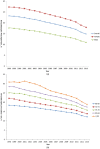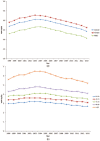Benzodiazepine prescription in Ontario residents aged 65 and over: a population-based study from 1998 to 2013
- PMID: 29492258
- PMCID: PMC5802639
- DOI: 10.1177/2045125317743651
Benzodiazepine prescription in Ontario residents aged 65 and over: a population-based study from 1998 to 2013
Abstract
Background: Although commonly used in anxiety and insomnia, recent guidelines recommend caution when prescribing benzodiazepines in the elderly. Here we examined rates of benzodiazepine prescribing to older adults in Ontario, Canada from 1998 to 2013 and impact of legislation that made prescribing regulations more strict.
Method: Annual benzodiazepine prescription rates for Ontario residents aged 65 and over were examined using the Ontario Drug Benefit database which captures all publicly funded prescriptions. Since most drugs, including benzodiazepines, are funded for residents aged ⩾65, data are essentially population-based. Weighted least squares regression methods were used to examine trends in prescribing rates (all benzodiazepines, anxiolytics, hypnotics, short- and long-acting drugs and individual drugs) from 1998 to 2013 for all Ontario residents aged ⩾65 and by sex and 5-year age bands. Impact on monthly prescribing rates of legislative changes (November 2011) which aimed to promote appropriate prescribing and dispensing practices for controlled substances, including requiring prescribers to record specified information, was assessed by constructing an interrupted time-series model.
Results: Benzodiazepines were prescribed to 23.2% of the 1,412,638 Ontario residents aged ⩾65 in 1998, declining to 14.9% of 2,057,899 residents aged ⩾65 in 2013 (p < 0.001 for trend). Rates were significantly greater throughout in older age bands (p < 0.001) and 1.54-1.62 times greater in females than males (p < 0.001). Lorazepam was the most prescribed benzodiazepine throughout, but rates declined from 11.4% in 1998 to 8.5% in 2013. Diazepam rates fell from 2.3% to 0.7%. However, clonazepam prescription rates increased until 2011, 1.7-fold overall. After the November 2011 legal changes, downward shifts were observed in total benzodiazepine prescription rates and for each drug individually. The step function, conditional on covariates, suggested benzodiazepine rates after November 2011 were 2.89 per 1000 (p < 0.001) below rates observed previously, representing a relative reduction of 4.8% compared to the year before the intervention.
Conclusion: Benzodiazepine prescribing rates declined markedly in this population from 1998 to 2013. Targeted legislation may have reduced rates, but the effect, although statistically significant, was small.
Keywords: anxiety; benzodiazepine; insomnia; pharmacoepidemiology; register.
Conflict of interest statement
Conflict of interest statement: The authors declare that there is no conflict of interest.
Figures





Similar articles
-
Controlled Substance Prescribing Patterns--Prescription Behavior Surveillance System, Eight States, 2013.MMWR Surveill Summ. 2015 Oct 16;64(9):1-14. doi: 10.15585/mmwr.ss6409a1. MMWR Surveill Summ. 2015. PMID: 26469747
-
Progressive trends in the prevalence of benzodiazepine prescribing in older people in Ontario, Canada.J Am Geriatr Soc. 2001 Oct;49(10):1341-5. doi: 10.1046/j.1532-5415.2001.49262.x. J Am Geriatr Soc. 2001. PMID: 11890493
-
Educating physicians to reduce benzodiazepine use by elderly patients: a randomized controlled trial.CMAJ. 2003 Apr 1;168(7):835-9. CMAJ. 2003. PMID: 12668540 Free PMC article. Clinical Trial.
-
Benzodiazepine Use, Misuse, and Harm at the Population Level in Canada: A Comprehensive Narrative Review of Data and Developments Since 1995.Clin Drug Investig. 2016 Jul;36(7):519-30. doi: 10.1007/s40261-016-0397-8. Clin Drug Investig. 2016. PMID: 27056579 Review.
-
Benzodiazepine Misuse: An Epidemic Within a Pandemic.Cureus. 2021 Jun 21;13(6):e15816. doi: 10.7759/cureus.15816. eCollection 2021 Jun. Cureus. 2021. PMID: 34306882 Free PMC article. Review.
Cited by
-
Impact of changes in controlled drugs legislation on benzodiazepine receptor agonist prescribing in Ireland: a repeated cross-sectional study.Eur J Clin Pharmacol. 2021 Jun;77(6):903-912. doi: 10.1007/s00228-020-03063-z. Epub 2021 Jan 7. Eur J Clin Pharmacol. 2021. PMID: 33410969 Free PMC article.
-
Cost trends of potentially inappropriate medications among older adults between 2012 and 2021 in Quebec, Canada: a population-based repeated cross-sectional study.BMC Geriatr. 2025 Aug 2;25(1):583. doi: 10.1186/s12877-025-06235-7. BMC Geriatr. 2025. PMID: 40753376 Free PMC article.
-
Comparative safety of chronic versus intermittent benzodiazepine prescribing in older adults: A population-based cohort study.J Psychopharmacol. 2022 Apr;36(4):460-469. doi: 10.1177/02698811211069096. Epub 2022 Feb 1. J Psychopharmacol. 2022. PMID: 35102786 Free PMC article.
-
Medication Prescribed Within One Year Preceding Fall-Related Injuries in Ontario Older Adults.Can Geriatr J. 2022 Dec 1;25(4):347-367. doi: 10.5770/cgj.25.569. eCollection 2022 Dec. Can Geriatr J. 2022. PMID: 36505916 Free PMC article.
-
Effects of an academic detailing service on benzodiazepine prescribing patterns in primary care.PLoS One. 2023 Jul 27;18(7):e0289147. doi: 10.1371/journal.pone.0289147. eCollection 2023. PLoS One. 2023. PMID: 37498812 Free PMC article.
References
-
- Wittchen HU, Jacobi F, Rehm J, et al. The size and burden of mental disorders and other disorders of the brain in Europe 2010. Eur Neuropsychopharmacol 2011; 21: 655–679. - PubMed
-
- Baldwin DS, Anderson IM, Nutt DJ, et al. Evidence-based pharmacological treatment of anxiety disorders, post-traumatic stress disorder and obsessive-compulsive disorder: a revision of the 2005 guidelines from the British Association for Psychopharmacology. J Psychopharmacol (Oxford, England) 2014; 28: 403–439. - PubMed
-
- Bandelow B, Lichte T, Rudolf S, et al. The German guidelines for the treatment of anxiety disorders. Eur Arch Psychiatry Clin Neurosci 2015; 265: 363–373. - PubMed
-
- NICE. Anxiety: generalised anxiety disorder and panic disorder (with or without agoraphobia) in adults. Clinical Guideline 113, 2011, www.nice.org.uk/guidance/cg113/chapter/About-this-guideline (accessed 15 November 2017).
LinkOut - more resources
Full Text Sources
Other Literature Sources

